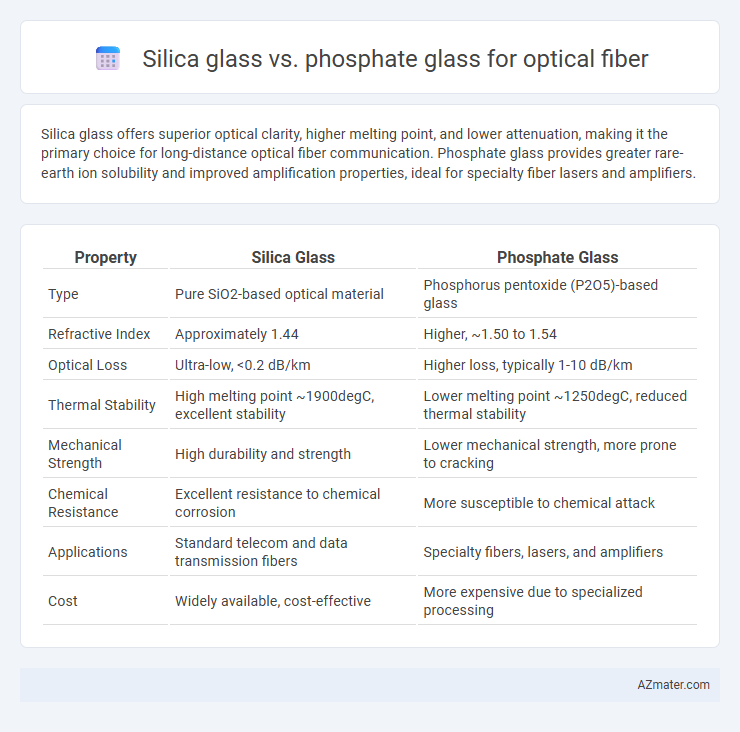Silica glass offers superior optical clarity, higher melting point, and lower attenuation, making it the primary choice for long-distance optical fiber communication. Phosphate glass provides greater rare-earth ion solubility and improved amplification properties, ideal for specialty fiber lasers and amplifiers.
Table of Comparison
| Property | Silica Glass | Phosphate Glass |
|---|---|---|
| Type | Pure SiO2-based optical material | Phosphorus pentoxide (P2O5)-based glass |
| Refractive Index | Approximately 1.44 | Higher, ~1.50 to 1.54 |
| Optical Loss | Ultra-low, <0.2 dB/km | Higher loss, typically 1-10 dB/km |
| Thermal Stability | High melting point ~1900degC, excellent stability | Lower melting point ~1250degC, reduced thermal stability |
| Mechanical Strength | High durability and strength | Lower mechanical strength, more prone to cracking |
| Chemical Resistance | Excellent resistance to chemical corrosion | More susceptible to chemical attack |
| Applications | Standard telecom and data transmission fibers | Specialty fibers, lasers, and amplifiers |
| Cost | Widely available, cost-effective | More expensive due to specialized processing |
Introduction to Optical Fiber Materials
Silica glass, primarily composed of silicon dioxide, is the most widely used material for optical fibers due to its excellent transparency, low attenuation, and high mechanical strength, making it ideal for long-distance communication. Phosphate glass, containing phosphorus pentoxide, offers higher rare-earth ion solubility and broader amplification bandwidth, making it suitable for specialized fiber amplifiers and lasers but generally exhibiting higher loss compared to silica. Optical fiber materials must balance transparency, mechanical durability, and dopant compatibility, with silica dominating in telecommunications and phosphate glass serving niche applications requiring enhanced doping flexibility.
Overview of Silica Glass
Silica glass, primarily composed of silicon dioxide (SiO2), is the most widely used material for optical fibers due to its exceptional optical transparency and low attenuation at telecommunications wavelengths. Its superior thermal stability, high mechanical strength, and resistance to radiation make it ideal for long-distance data transmission and high-power laser applications. Compared to phosphate glass, silica glass offers better chemical durability and lower signal loss, which significantly enhances the performance and reliability of optical fiber networks.
Overview of Phosphate Glass
Phosphate glass offers distinct advantages in optical fiber applications, including higher rare-earth ion solubility and broader infrared transmission compared to silica glass. This type of glass exhibits lower melting temperatures and greater gain bandwidth, making it suitable for high-performance fiber lasers and amplifiers. Its fabrication flexibility enables tailored properties for specific photonic devices, despite generally higher optical losses than silica-based fibers.
Optical Properties: Silica vs Phosphate Glass
Silica glass offers exceptional optical transparency and low attenuation across a wide spectral range, making it the preferred material for high-performance optical fibers. Phosphate glass, while exhibiting higher rare-earth ion solubility for amplified spontaneous emission applications, generally has greater optical loss and lower mechanical strength compared to silica. The higher intrinsic purity and low hydroxyl content in silica glass result in superior signal transmission efficiency and reduced scattering losses.
Chemical Stability and Durability
Silica glass exhibits superior chemical stability and durability compared to phosphate glass, making it the preferred choice for optical fibers in harsh environments. The high resistance of silica to moisture, chemicals, and thermal degradation ensures long-term performance and minimal signal loss. Phosphate glass, while easier to fabricate with a lower melting point, is more susceptible to chemical corrosion and environmental degradation, limiting its durability in demanding applications.
Transmission Windows and Attenuation
Silica glass exhibits low attenuation and broad transmission windows spanning from ultraviolet (around 200 nm) to near-infrared wavelengths (up to 2.2 um), making it ideal for telecom and data communication fibers. Phosphate glass offers broader transmission in the mid-infrared range (up to ~4 um) but suffers from higher intrinsic attenuation compared to silica, limiting its use in long-distance optical fibers. The superior optical clarity and minimal signal loss of silica glass ensure its dominance in applications requiring low attenuation and extensive transmission bandwidth.
Fabrication and Processing Differences
Silica glass optical fibers are fabricated through a vapor deposition process, such as Modified Chemical Vapor Deposition (MCVD), which produces high-purity glass with excellent mechanical strength and low optical attenuation. Phosphate glass fibers, created by melting phosphate compounds followed by fiber drawing, allow easier doping with rare-earth ions but exhibit lower chemical durability and higher intrinsic loss compared to silica fibers. The processing of phosphate glass requires precise temperature control to prevent crystallization, while silica glass benefits from a well-established, high-temperature fabrication method enabling superior thermal stability.
Cost and Availability Considerations
Silica glass dominates the optical fiber market due to its low cost and widespread availability, making it the preferred choice for long-distance and high-performance telecommunications. Phosphate glass, though offering unique optical properties such as higher rare-earth ion solubility, remains significantly more expensive and less abundant, limiting its use to specialized applications like fiber lasers and amplifiers. Cost-efficiency and mass production infrastructure heavily favor silica glass in commercial optical fiber deployment.
Application Suitability and Use Cases
Silica glass excels in high-performance optical fibers due to its exceptional transparency, low attenuation, and thermal stability, making it ideal for long-distance telecommunications and high-speed data transmission. Phosphate glass offers higher rare-earth ion solubility and customizable refractive indices, making it suitable for specialty fibers in laser amplifiers and medical imaging applications. While silica dominates mainstream fiber-optic communication, phosphate glass fibers are preferred in niche applications requiring enhanced nonlinear optical properties or specific active doping.
Future Trends in Optical Fiber Material Science
Silica glass remains the dominant material in optical fiber manufacturing due to its excellent thermal stability and low optical attenuation, but phosphate glass is gaining attention for its higher rare-earth ion solubility, enabling advanced fiber laser and amplifier designs. Emerging research in optical fiber material science focuses on hybrid glass compositions and nanostructuring techniques to enhance nonlinear optical properties and signal amplification efficiency. Future trends emphasize the integration of phosphate glass-based fibers in next-generation communication systems, leveraging their superior doping capabilities to achieve higher data transmission rates and energy-efficient photonic devices.

Infographic: Silica glass vs Phosphate glass for Optical fiber
 azmater.com
azmater.com